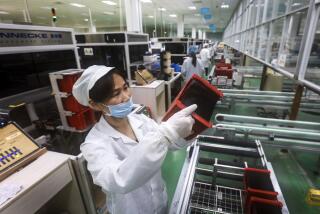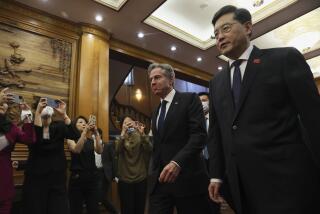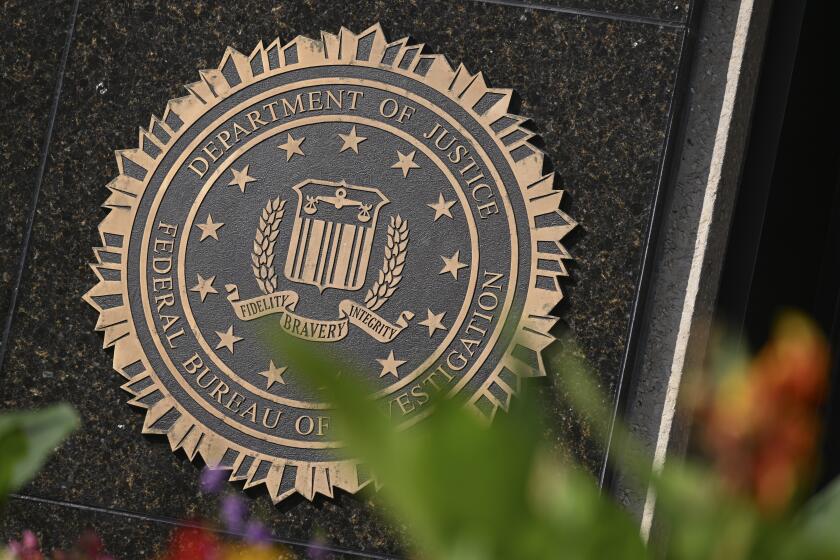Escalating U.S.-China trade war roils markets as Trump promises aid to farmers

As China hit the U.S. with retaliatory tariffs and the stock market tumbled, President Trump moved Monday to shield American farmers, but also expressed hope that a possible meeting next month with Chinese President Xi Jinping could resolve their escalating trade war.
Even as Trump defended his heavy use of tariffs to extract trade concessions from China, he told reporters at the White House that he planned to see Xi at the Group of 20 leaders’ summit in Japan in late June. He said that it would probably be “a very fruitful meeting.”
In the meantime, Trump said he was devising a new relief package for farmers of about $15 billion, an amount that he said was equivalent to the largest Chinese purchase of U.S. agricultural goods. U.S. agricultural exports to China reached $19.6 billion, more than 14% of total U.S. agricultural exports, in 2017 before falling sharply in 2018 as the trade war got underway.
The administration last year provided $12 billion in farm aid after China’s retaliatory tariffs hammered producers of soybean and other products.
“They’ll be planting. They’ll be able to sell for less, and they’ll make the same kind of money until such time as it’s all straightened out,” Trump said. “So our farmers will be very happy.”
His comments came after China announced new tariffs on $60 billion in U.S. goods, saying it would “never surrender” to outside pressure.
China published a list of more than 5,000 items that would be hit by tariffs of 5% to 25% covering a wide range of U.S. goods including agricultural products but also chemicals, metals and fabrics.
Stock markets worldwide fell significantly on the news. The Dow Jones industrial average lost 617 points, or 2.4%, the biggest drop since Jan. 3.
Both sides have given themselves some room to continue negotiating a way out of the escalating trade conflict. The new Chinese tariffs don’t take effect until June 1, and the higher tariffs that Trump announced last week on Chinese goods also mostly have a delayed effect.
Also, China has invited U.S. negotiators to Beijing to continue talks, and Trump’s announcement that he would attend the G-20 meeting offered additional hope that the two sides could put an end to a yearlong trade battle between the two largest economies.
But although those delays and talks provide a potential off-ramp, neither side sounded in a hurry to take it.
“We have said many times that adding tariffs won’t resolve any problem. China will never surrender to external pressure. We have the confidence and the ability to protect our lawful and legitimate rights,” Chinese Foreign Ministry spokesman Geng Shuang said at a briefing.
A few hours before China announced its action, Trump warned in a tweet that “China should not retaliate-will only get worse!”
“I say openly to President Xi & all of my many friends in China that China will be hurt very badly if you don’t make a deal because companies will be forced to leave China for other countries. Too expensive to buy in China. You had a great deal, almost completed, & you backed out!” he said in another tweet.
Later Monday, he said that the U.S. is in a good position economically to battle China, and that the fight will yield money for the Treasury.
“We’ve never taken in 10 cents until I got elected. Now we’re taking in billions and billions,” he said, referring to revenue from the tariffs. “This is a very positive step. I love the position we’re in.”
Trump administration officials have acknowledged, however, that escalating tariffs will hurt both economies. Tariffs are taxes on imports. Although Trump often says the tariffs are paid by China, they’re not: Consumers and the firms that import goods pay the cost.
Just a couple of weeks ago, businesses and investors were optimistic amid signs that a U.S.-China trade deal was close after multiple rounds of talks. But a dramatic hardening of positions on both sides in recent days has jolted markets and alarmed international leaders who are fearful a full-blown trade war could harm the global economy.
After trade talks in Washington broke off Friday and the Trump administration went ahead and hiked taxes on $200 billion of imported Chinese goods to 25% from 10%, a Chinese response was widely expected.
Chinese state media blamed Washington for the crisis and argued that China’s economy and political system were strong enough to outlast the U.S. in a battle of wills.
The editor of the Communist Party-owned Global Times, Hu Xijin, earlier tweeted that China’s countermeasures would be carefully designed to ensure that its plan “hits the U.S. while minimizing damage to itself.”
The Finance Ministry said in a statement that the latest tariffs were “a response to unilateralism and trade protectionism.”
“China hopes that the United States will return to the right track of bilateral trade negotiations, work together with China and meet China halfway to reach a mutually beneficial, win-win agreement on the basis of mutual respect and equality,” the ministry statement said.
After talks ended Friday without agreement, Vice Premier Liu He, Xi’s chief negotiator, publicly spelled out his country’s demands in comments to Chinese media: All additional tariffs must be lifted; demands that China buy more from the U.S. should be realistic; and a final deal should be “balanced.”
Liu, however, didn’t say what he meant by “additional” tariffs, as there had been three rounds of tariffs before Friday’s. That could give the Chinese and U.S. negotiators more latitude for compromise; American officials have sought to keep some tariffs in place to enforce any agreement reached between the two countries.
Administration negotiators led by U.S. Trade Representative Robert Lighthizer have been insisting that Beijing agree to enforcement mechanisms on any deal. Washington has long complained that China’s negotiating strategy has involved keeping commitments as vague as possible.
Trump has so far slapped 25% tariffs on a total of $250 billion of Chinese goods. He took his first action in June after his administration concluded that China has for many years engaged in intellectual property theft and policies that coerce U.S. firms to hand over technologies in order to gain access to Chinese markets.
His next threatened step would be to impose 25% tariffs on all of the remaining Chinese merchandise that enters the U.S. — roughly $300 billion more worth of goods. That would include many consumer products, including such high-profile imports as iPhones, which are not currently subject to import taxes. A public hearing on these tariffs has been set for June 17.
Trump said Monday that “I have not made a decision yet” on those further tariffs, although he noted that “that is a tremendous amount of money that would come into our country.”
Since the trade fight began, China has imposed new or higher duties on $110 billion of American imports. Last year China imported about $156 billion of merchandise from the United States, according to China’s customs data. (U.S. data put the figure at about $120 billion.)
State media, which had been restrained during much of the conflict with the United States, lashed out at the Trump administration and voiced China’s determination to prevail. An opinion piece in the People’s Daily condemned Washington’s “reckless leap into the dark” and said China would never compromise on matters of principle.
“The U.S. wielded the tariff stick once again because it misjudged China’s strength, capability and willpower. By further escalating the trade tensions, does it really want to push its trade ties with China to the breaking point?” read a piece bearing the byline Zhong Sheng, a pen name often used by the daily to express its opinions on foreign policy.
A Global Times editorial said Washington’s “fierce offensive” would hurt America more than China.
The U.S.-China trade war just got a lot worse. And there’s no quick fix for relations »
“Washington obviously hopes that the fierce tariff war, which is unprecedented in trade history, will crush China’s will in one fell swoop and force China to accept an unequal deal in a short term,” said the newspaper.
“However, once the country is strategically coerced, nothing is unbearable for China in order to safeguard its sovereignty and dignity as well as the long-term development rights of the Chinese people.”
At the heart of the trade issue is Washington’s complaint that China failed to live up to commitments it made to open up the nation’s economy to foreign companies when it joined the World Trade Organization in 2001. The U.S. complains that China has blocked market access to key areas of its economy, forced foreign companies to surrender trade secrets and subsidized state-owned companies in strategic technology sectors, giving them an unfair trade advantage.
Although the U.S. presidential election is 18 months away, the political space for compromise with Beijing appears to be shrinking fast, with Trump unwilling to look weak on China.
Meanwhile, Xi is also unwilling to look as if he has been bullied into a deal by Trump.
Robert Z. Lawrence, senior fellow with the Peterson Institute for International Economics in Washington, argues that China may have miscalculated, believing that Trump needed a deal for political reasons in the lead-up to elections. Instead, he said, Trump saw Friday’s tariff hike as delivering on a long-held promise.
“This is one of the few things that Donald Trump has had the intention of [doing] — imposing 25% tariffs on China, and that is what he is achieving,” Lawrence said. “He’s very enthusiastic about these tariffs.”
Dixon reported from Beijing and Lee from Washington. Gaochao Zhang of The Times’ Beijing bureau contributed to this report.
Twitter: @RobynDixon_LAT
More to Read
Sign up for Essential California
The most important California stories and recommendations in your inbox every morning.
You may occasionally receive promotional content from the Los Angeles Times.











